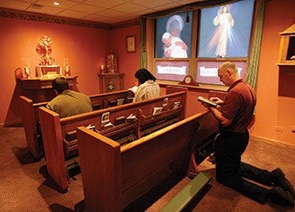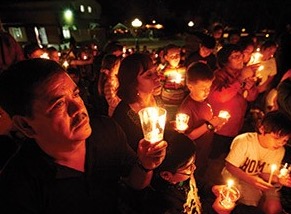For the devout Catholic, nothing we do is more intimate or more adoring than receiving the Eucharist, the Body and Blood of Christ, in holy Communion.
In this beautiful Sacrament we experience and unite ourselves to Jesus. Holy Mother Church has long provided us with devotions that extend this miraculous event beyond the confines of the Mass. Such devotions are commonly known as Eucharistic Adoration.
During the first 300 years of Christianity, there were no organized, separate acts of Eucharistic Adoration outside Sunday worship services. After Emperor Constantine stopped the persecution of Christians in A.D. 313, construction of churches began and the reserved Eucharist for the sick was kept in the church and often secured in the sacristy. Over the next several centuries, the Eucharist was relocated out of the sacristy and stored in locations around and above the church altar. While not necessarily purposeful at the time, this encouraged personal prayer in the presence of the reserved Host.
“Gazing” Adoration
In the Middle Ages, the practice developed of people taking Communion less frequently, and the Church eventually decreed that everyone should receive holy Communion at least once a year. Further reflecting these changing attitudes, altars were moved away from the congregation and, in some churches, screens were placed between the sanctuary and the nave as if to separate the priest-celebrant from the people.
Being physically separated from the actions around the altar and infrequently receiving holy Communion gave rise to the phenomena of “adoration by seeing or gazing” — that is, people adored the Eucharist by looking at it as opposed to receiving the Body and Blood of Christ. The fact that people did not receive Communion did not mean that they stopped believing in the Real Presence of Jesus in the Eucharist.
Indeed, Mass attendees gave special attention to the moments when the priest elevated or lifted up the consecrated Host, and people came to Mass early seeking good locations for viewing the priest holding up the Host. Due to church structure and the use of Latin, it was often difficult to both see and understand what was happening around the altar. Thus the elevation was preceded by the ringing of a bell as an alert that the Host was being lifted up. Those in the congregation would excitedly move around to see this great event.
It was common for people to adore the elevated Host in one church and then rush to Mass at another location to again look at the Eucharist. Many Church historians point to this period, when the elevation was added to the Mass, as the beginning of Eucharistic exposition, prolonged adoration and the earliest contemplation of a monstrance.
Corpus Christi
The solemnity of the Body and Blood of Christ, what we refer to as Corpus Christi Sunday, began in the 13th century. About 1209, St. Juliana, a nun in a monastery near Liege, Belgium, had a series of visions in which our Lord Jesus asked her to promote the creation of a special feast day that would honor and adore His Eucharistic presence. Twenty years later, Juliana told the local bishop, Bishop Robert de Thorete (or Torote), of her visions.
Although the idea originally met with some hesitation, in 1246 Bishop Thorete ordered the feast of Corpus Christi be implemented throughout his diocese. In 1264, Pope Urban IV (r. 1261-1264) issued a papal bull instructing that the feast day be celebrated annually throughout the universal Church. Although Pope Urban died before the directions of the papal bull were instituted, the feast was eventually added to the worldwide Church calendar in 1317 during the reign of Pope John XXII (1316-1334).
Initially, a procession was not part of the feast day but soon became a fact. The laity was still receiving holy Communion on an infrequent basis, and the cult of adoration by gazing at the Eucharist continued.
One way to prolong the viewing and demonstrate their adoration was to carry the Eucharist in a Corpus Christi day procession. Some of these processions, which began in Europe during the 14th century, involved laity and clergy marching behind the bishop who carried a monstrance containing the Blessed Sacrament. In the early 1300s, Corpus Christi processions were concluded with Benediction or a blessing of the people, and by 1600 the Church had issued detailed instructions for conducting Benediction. Today, most Eucharistic devotions typically end with Benediction. These public Corpus Christi processions, exposing the Blessed Sacrament outside the tabernacle, were the forerunner of the Forty Hours devotion.
Forty Hours
Church history indicates that 12th-century Christians were among the first to keep a 40-hour prayer vigil and did so during the Easter Triduum. Forty hours was the time Jesus lay in the tomb. It is less certain whether or not the Blessed Sacrament was exposed during the vigils. Exposition of the Blessed Sacrament outside Mass, what today we commonly refer to as Eucharistic Adoration — that is, taking the Blessed Sacrament from the tabernacle and placing it on the altar for an extended period — can be traced to the 16th century. In 1537, the churches and faithful of Milan, Italy, began celebrating 40 hours of prayer at times other than during the Triduum.

People pray at the Pope John Paul II Chapel of Eucharistic Adoration at St. James the Greater Catholic Church, Sauk Village, Ill. Picture by Karen Callaway
When the devotion ended in one church, the Blessed Sacrament was carried to another church, where the Eucharist would be exposed on the altar during another 40 hours of prayer. It would then be carried to the next church and so on.
The anticipated invasion by a Turkish army into Italy in 1541 led Pope Paul III (r. 1534-1549) to issue an indulgence to the Diocese of Milan that reads, in part, “the Archbishop of Milan, at the prayer of the inhabitants of said city, in order to appease the anger of God provoked by the offences of Christians, and in order to bring to nought the efforts and machinations of the Turks who are pressing forward to the destruction of Christendom, amongst other pious practices, has established a round of prayers and supplications to be offered both by day and night by all the faithful of Christ, before our Lord’s Most Sacred Body, in all the churches of the said city, in such a manner that these prayers and supplications are made by the faithful themselves relieving each other in relays for forty hours continuously in each church in succession.”
The devotion, especially in light of the Protestant revolt in the 16th century, spread rapidly across Europe, including Rome, where in 1592 Pope Clement VIII issued a papal decree, Graves et diuturnae, which mandated the continuous observance of the Forty Hours devotion in the churches of Rome. Later, Popes Clement XI (r. 1700-1721) and Clement XII (1730-1740) issued instructions and rubrics, most still used, detailing the Forty Hours devotion.
In 1853, St. John Neumann introduced the devotion to the United States. The 1917 Code of Canon Law required all parishes to annually celebrate Forty Hours adoration, but in 1983 the law was changed, and today canon law only recommends annual exposition of the Blessed Sacrament. Holy hours of adoration and First Friday celebrations are products of Forty Hours.
Among the most practiced of our Eucharistic devotions is prayer before the tabernacle. As Catholics we can walk into any Catholic church, visually find the red light, then silently pray, honor and adore the Real Presence of Jesus in the most holy Sacrament.
Prior to every Mass, we give our thoughts to the Eucharistic Jesus veiled in the tabernacle, we stay after Mass to pray before the same Blessed Sacrament, and when exiting the confessional, our penitential prayers are often offered near the tabernacle. There is general agreement among Church experts that adoration of the reserved Eucharist in a tabernacle began at the end of the 11th or 12th centuries.
Perpetual Adoration
Perpetual adoration — that is, continuous prayer 24 hours a day — before the Blessed Sacrament can be traced in the Western Church to the sixth century. It was then referred to as “continuous praise” and found mostly in monasteries or religious communities. Among the earliest locations is the cathedral in Lugo, Spain, where prayer before the blessed Sacrament was continuous for over 1,000 years.

Father Miguel Martinez leads participants in prayer following a Eucharistic Procession at the Shrine of Our Lady of Guadalupe in Des Plaines, Ill. Picture by Karen Callaway
In 1226, King Louis VIII of France, at the Chapel of the Holy Cross in Avignon, introduced continuous adoration as thanksgiving for his successful efforts to end the Albigensian heresy. This heretical group rejected Catholicism in general and the Real Presence of Jesus in the Eucharist in particular. The people of Avignon continuously prayed night and day in the Holy Cross chapel for the next 500 years.
While Church history identifies several religious groups and locations where perpetual adoration was practiced, it wasn’t until some time between the 15th and 17th centuries that the devotion expanded on a universal basis.
Among the notable 19th-century Catholics advocating adoration of the Eucharist outside the Mass, especially perpetual adoration, was St. Peter Julian Eymard (1811-1869).
St. Peter, sometimes called the Apostle of the Eucharist, championed continuous Eucharistic Adoration and formed orders of both religious men and women dedicated to the worship and glorification of God through the Most Blessed Sacrament.
From these early efforts, perpetual adoration has expanded to Catholic parishes, chapels and oratories throughout the world.
D.D. Emmons writes from Pennsylvania.


